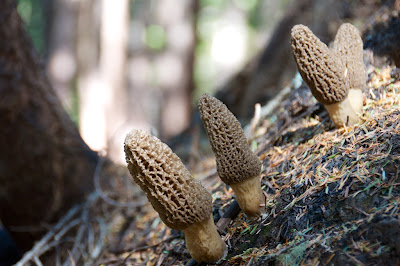
The first day I visited the burn, in early June, there wasn’t a car in sight. The fire had burned right down to the logging road and a trailhead was marked off with police tape. Signs warned of falling trees and other dangers. We could see the morels before getting out of the car.
Over the next week or two a few other pickers trickled in. To the south, a large, well-publicized burn was taking all the pressure—though I knew it couldn’t last. By the time this smaller patch was on the radar, I’d dried enough morels for several winters and many holiday gifts. After a few weeks of staying away, I went back the other day. Again, not a car in sight. The conica morels were long gone for the season.

But not the grays. While the morel season is winding down in Washington State (some years, with enough summer rain, you can pick burn morels well into fall in the Northwest), the last of the burn morels are fruiting in limited numbers at the higher elevations. Conditions might be different up in British Columbia.

Just the same, the last act is a good one. Finding clusters of big grays always makes my heart skip a beat. The gray morel (Morchella tomentosa) is the easiest of the many burn morels to identify. In its youth it has a distinctly gray cap that’s densely pitted, and unlike other species it also has a dark stem with a nearly rubbery texture. Under a microscope you can see lots of little hairs at the base of the stem, hence its other common name, fuzzy-foot. Grays can be quite large, and mature specimens seem to have two color phases, gray and light yellow, for reasons that are not entirely clear. Commercial pickers sometimes call the big yellow ones blonds, not to be confused with the mountain blond (Morchella frustrata).
The photo at top shows a pod of mature grays, each of them several inches tall. Notice how the stems appear white at this stage, in contrast to the dark stems of younger grays. As these morels age, the stems lose their gray exterior and the ridges on the cap become sharp and brittle. As little bits of the ridges crumble off, the cap takes on a speckled look. Now look at these younger, smaller specimens below.

The shape and coloration is variable. Of the nine in this picture, all but one still have dark outer stems that contrast noticeably with the inner white where they’ve been cut. The pits on the smallest are elongated and barely open. A few of these, particularly those three on the right, appear to be maturing into the blond form.
Grays often command a slightly higher price in the market place because of their beauty and meatiness, even if their flavor is mild compared to other species.

I also found a few greenies, or pickles, the other day. At first I wasn’t sure what species these were, but Jeremy Faber of Foraged and Found Edibles confirmed them as greenies based on these photos.
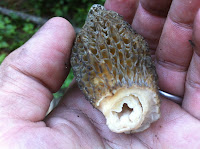
Notice the multi-layered stem when cut (at right). Sometimes the stem is so thick it appears solid, as seen in the photo at lower left. To my eye, these morels look quite a bit different from the greenies I saw in the Yukon two years ago, which were considerably larger and darker, with noticeably dense pitting like gray morels. Faber suggested that the lack of moisture this season has prevented this variety from attaining its usual size and coloration. They were scattered in the burn mostly as singletons, with perhaps a dozen in all making it into my bucket.

Some mycologists dispute the existence of greenies, considering them just another form of typical burn morel known in the industry as conica, of which there are probably several hard-to-separate species that require microscopic study and DNA analysis for identification. Still, the greenie familiar to commercial pickers has its own distinct appearance and it’s always the last to show in the burn, if it shows at all. The species that it seems to come closest to in the recent taxonomic reclassification of morels is Morchella capitata, but I wonder whether it’s in fact a species that has yet to be described by science. No doubt the mystery surrounding greenies will be unraveled in coming years as morel classification continues to be a hot topic among mycologists.
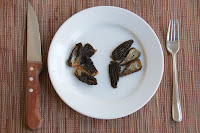
So, what about the taste? Unfortunately there wasn’t a conica in sight the other day, and the non-burn morels have been done in my habitat since mid-June. That leaves grays and greenies to duke it out. Most western morel enthusiasts rank the non-burn “natural” black morel as the tastiest, with conica next. Mountain blonds, though beautiful, tend to lack strong flavor, and the early season logging morels are generally derided as unsightly. And those late-flushing burn morels?
I put two grays and two greenies head to head in a summer burn morel taste-off. They got simply sautéed side by side in butter, with a sprinkling of salt. The grays, it must be said, had tremendous texture: meaty, chewy, crisp on the outside. The greenies, however, get the nod for taste. I won’t bore you by waxing grandiloquent like a wine snob. The bottom line is that I was reminded yet again that morels don’t really taste all that much like mushrooms; they taste like something that hasn’t been named yet—a mixture of meat and fungus that pleases the palate with its burst of umami. And for this reason, they made an excellent accompaniment to my first beach-caught salmon of the season, in a summer risotto, along with chard and tomatoes from the garden.
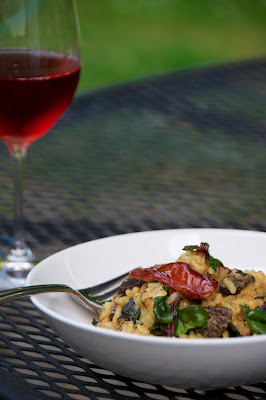
Like this:
Like Loading...



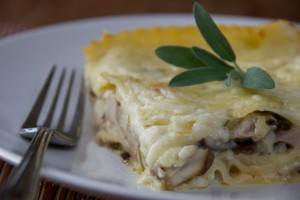
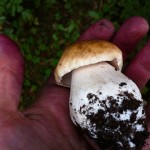






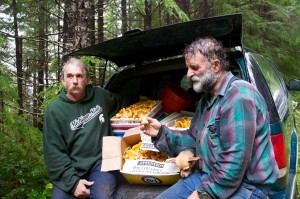



























.jpg)





